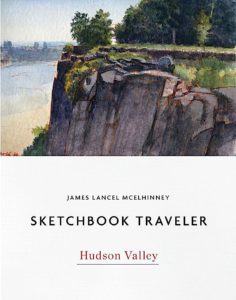Here in New York City, the darkest days of the pandemic may soon be over. Elsewhere others brace themselves for the fury of its onslaught. Many thanks to you who shelter in place. Shame on those who do not
One week ago I published the first in a series of daily blog-posts, of writings and artworks that celebrate personal mobility, in pursuit of mindful engagements with history, nature and the environment. In relation to a finished painting, or an essay, this process is no less a work of art than is the tree to the fruit it bears. In a sense, this practice may be ceremonial, acts of reverence, in beholding the world around us. Offered as messages of hope and solidarity, these quotidian posts will appear every day, until these dark days are behind us.

Twin Bridges at the Mouth of the Sacandaga River, Hadley New York.
Traveling down the Hudson in 1820 with Irish landscape painter William Guy Wall, travel-writer John Agg describes the land around the mouth of the Sacandaga as,
“…broken and precipitous; and the natural course of the current is impeded and distracted by large fragments of stone, which choke up the narrow channel. The character of the scenery is wild, ferocious and solitary sublimity; lofty and irregular acclivities, covered the gloomy verdure of interminable forests and glens; over whose terrific depths unchanging darkness lowers.”
On a visit to old friend and noted author James Howard Kunstler, we head out to paint au plein-air. Below Hadley, we park alongside the Old Corinth Road, then descend a steep embankment. Setting up on a grassy rise, along the banks of the Sacandaga, to our left we find two historic bridges. The oldest is a parabolic-lenticular bow-truss bridge, resting on stone piers. Built in 1885 to replace the earlier bridge Agg and Wall had beheld, sixty-five years before, by 1994 it had fallen into disrepair. Deemed unsafe, the bridge closed to traffic in 1994. Five years later, Saratoga County considered replacing the bridge. Preservationists raised funds to restore the bridge, which reopened to traffic in 2005. Beyond it we see a steel deck-truss railroad-bridge, also built on stone piers in 1943. The day was hot. Mosquitoes vexed us without mercy. Jim waves at a fisherman wading in the stream.
Departing at end of the day, we cross the Hudson. Looking back toward our motif from the prospect Wall had taken, The rocky stream is as it had been, two hundred years before. Much had changed. Pastures and meadows have disappeared. Spreading over the land a new forest stands, as far as the eye can see. Wild-space has reclaimed its own, save for two relics of human desire, in the geometry of these twin bridges.

William Guy Wall. The Junction of the Hudson and Sapandaga Rivers. No. 2 of the Hudson River Port-Folio. 1821. Collection of Metropolitan Museum of Art, New York. Reproduced under fair use, etc.
Note: Standard spelling of indigenous names did not exist when Wall and Agg visited the Hadley-Luzerne area in 1820. Names were spelled phonetically, according to the whim of the writer. Sapandaga today is spelled Sacandaga.
(A preview of SKETCHBOOK TRAVELER by James L. McElhinney (c) 2020. Schiffer Publishing).
Copyright James Lancel McElhinney (c) 2020 Texts and images may be reproduced (with proper citation) by permission of the author. To enquire, send a request to editions@needlewatcher.com
